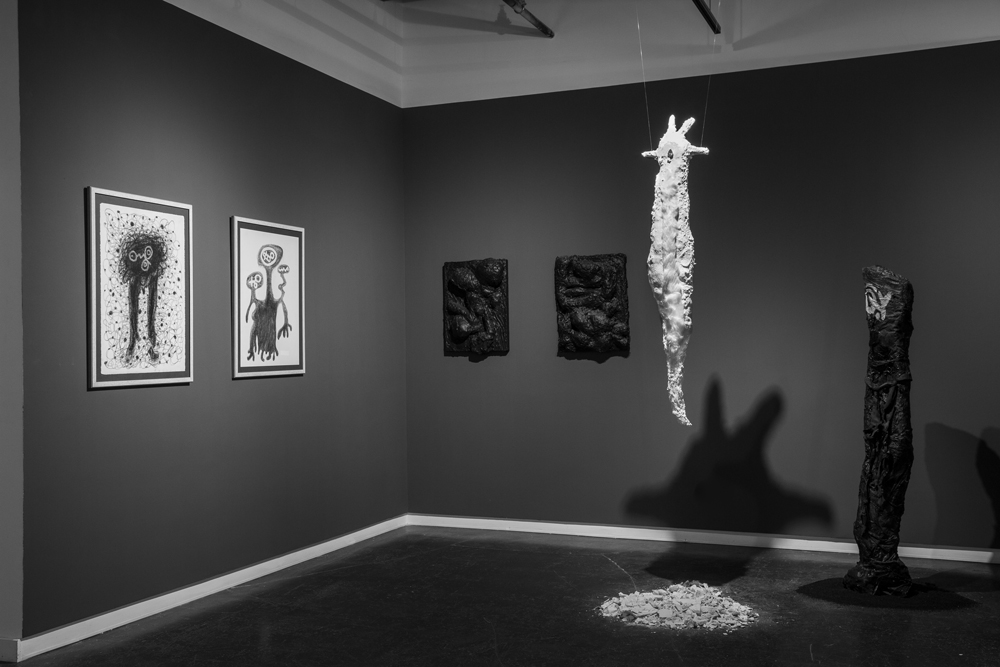Christopher E. Harrison: A Monster Anthology
Review II by Nicole Thomas
Soo Visual Arts Center
Aug 4–Sept 8, 2018

A vibrant orange reflects throughout the space, pulling me inwards. I am immediately confronted with an archeological excavation site. Red-orange sculptures emerge from dirt on the gallery floor. As a visitor I become an anthropologist with a desire to piece together the evidence.
The artifacts include plaster and clay sculptures, paintings on creased canvas and drawings on paper. Primitive in craft, yet futuristic in color. At first glance the exhibition fills you with joy and naive curiosity. It’s bright, gooey and colorful, filled with soft fuzzy textures, touches of shiny mylar and rough sand. The subjects are inhuman, figurative with limbs and ancient symbols that resemble facial features. Many of the sculptures are cheerful and approachable, small enough to hold like a stuffed toy. In contrast, the larger figures are more daunting and somber. In a gray room, Eidolon floats above its remains and Sentry overlooks. It appears to be a scene of death.
Christopher E. Harrison’s artist statement mentions the importance of “diverse streams of inspiration, pooling ancient crafts ranging from African, Pre-Columbian and Native American cultures.” Due to his immense research, he intermingles ancient languages, historical references and a mixture of scientific and biblical terminology. The words feel as important to me as the visual art. There aren’t explanatory didactics or dates to reference, only titles and an anthology of poetry. So I find myself Googling Medieval terms such as Eidolon, Sentry, Sorcerer, Griot, and trying to find the ancient scripture that appears on the Monsters’ faces. This leads me down a rabbit hole of various overlapping histories. It’s overwhelming to approach at first, especially while there is an orange glow dispersed throughout the room. I don’t feel like a gallery visitor, but an anthropologist, as the work asks for more research than viewing.
Because of this anthropological perspective I’m able to remove myself from societal conditioning and simply observe a cartoonish, fictional species without much consequence. The Monsters are birthed from eggs and have a matriarchal society. Visually, Harrison’s installation illustrates opposing forces, signifying a utopia and dystopia of the monster’s history. Eden is an abstracted landscape with smooth shapes in earthy tones. It’s hypnotic to look at as it flows in and out of itself. Contrarily, The Lovely War (Two Tribes) is abrasive, moving outward with various textures collaged haphazardly. Balance is restored through the accompanying anthology of poems. Genesis further describes a rebirth after war as “exhilarate, rejuvenate with unity, grace;/inhale, exhale, enlighten, elate!” This arrangement demonstrates that like many species, the monsters have a rise, a fall, and a rebirth.
It’s a bite size look at a larger community and I can only relate it to human history. As I read about the origin of Harrison’s words, I think about the Middle Ages, when castles and armored men protected village people and royalty. Winners of war would destroy an empire and take what they wanted. While losers, left behind in a pile of dirt, would have to rebuild stronger forces to conquer. Throughout history, stories of wealthy, abundant armies aren’t illustrated as brave or thrilling. It’s the stories about a courageous bunch of people with limited resources that bring a society forward. Those stories of perseverance encourage future generations to keep rising after they fall, even when circumstances tell them it’s impossible to keep going.
